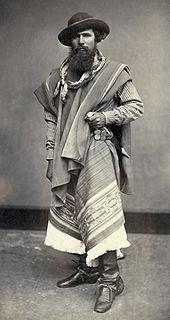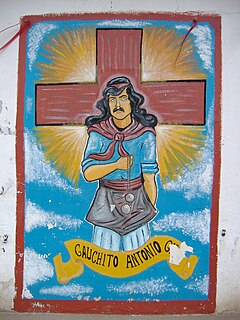 W
WA bolas is a type of throwing weapon made of weights on the ends of interconnected cords, used to capture animals by entangling their legs. Bolas were most famously used by the gauchos, but have been found in excavations of Pre-Columbian settlements, especially in Patagonia, where indigenous peoples used them to catch 200-pound guanaco and ñandú (birds). The Mapuche and the Inca army used them in battle. Researchers have also found bolas in North America at the Calico Early Man Site. Mapuche warriors used bolas in their confrontations with the Chilean Army during the Occupation of Araucanía (1861–1883).
 W
WMiguel Ángel Gaitán, also known as El Angelito Milagroso was an Argentine baby who died of meningitis, fifteen days before his first birthday.
 W
WA gaucho or gaúcho is a skilled horseman, reputed to be brave and unruly. The figure of the gaucho is a folk symbol of Argentina, Uruguay, Rio Grande do Sul in Brazil, and the south of Chilean Patagonia. Gauchos became greatly admired and renowned in legend, folklore, and literature and became an important part of their regional cultural tradition. Beginning late in the 19th century, after the heyday of the gauchos, they were celebrated by South American writers.
 W
WThe Gauchito Gil is a folk religious figure of Argentina's popular culture. Allegedly born in the area of Pay Ubre, nowadays Mercedes, Corrientes, possibly in the 1840s, and died on 8 January 1878. He is regarded as the most prominent folk hero in Argentina, with smaller areas of veneration reported in Paraguay, Chile and Brazil.
 W
WJuan Moreira is a well-known figure in the history of Argentina. An outlaw, gaucho and folk-hero, he is considered one of the most renowned Argentinian rural bandits.
 W
WMurga is a form of popular musical theatre performed in Montevideo, Uruguay, Panama, Argentina and Badajoz, Spain during the Carnival season. Murga groups also operate in the Buenos Aires Carnival, though to a lesser extent than in Montevideo; the Argentine murga is more centred on dancing and less on vocals than the Uruguayan one. Uruguayan murga has a counterpart in Cadiz, Spain from which it is derived, the chirigota, but over time the two have diverged into distinct forms.
 W
WNahuelito is a cryptid lake monster purported to live in Nahuel Huapi Lake, Patagonia, Argentina. Like Nessie, the Loch Ness Monster, the Argentine creature is named after the lake it supposedly resides in and has been described as a giant serpent or a huge hump, as well as a plesiosaur. Nahuelito has been allegedly shown through photos showing a hump, or a serpentine body.
 W
WThe payada is a folk music tradition native to Argentina, Uruguay, southern Brasil, and south Paraguay as part of the Gaucho culture and literature. In Chile it is called paya and performed by huasos. It is a performance of improvised ten-line verse called décimas usually accompanied by guitar. The performer, is called a "payador", albeit any guitar performer in the region is called by the same name, and in performances of two or more payadores, known as contrapunto, they will compete to produce the most eloquent verse, each answering questions posed by the other, often insulting. The durations of these verse duels can be exceedingly long, often many hours, and they end when one payador fails to respond immediately to his opponent. Musical styles often used in the payada are the cifra, the huella and the milonga.
 W
WSan La Muerte folk saint and the personification of death, it is represented as a skeletal idol wearing a hooded cloak in Latin America. Paraguay, Argentina and southern Brazil are the main centres of the cult of San La Muerta. As the result of internal migration in Argentina since the 1960s the veneration of San La Muerte has been extended to Greater Buenos Aires and the national prison system as well.
 W
WSantos Vega was a mythical Argentine gaucho, and invincible payador, who was only defeated by the Devil himself, disguised as the payador Juan sin Ropa.